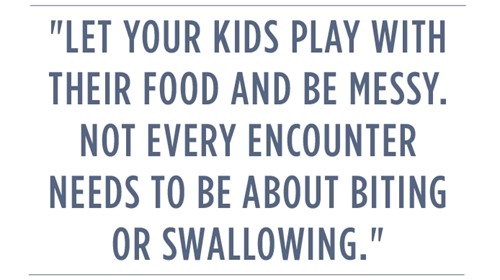Feeding toddlers: it's tricky when they're picky

Most kids have their quirks when it comes to eating, but some are particularly hard to please. Hannah Gentile shares 10 tips for managing fussy eating in toddlers.
Chicken nuggets, oven chips and a couple of carrot sticks on the menu in your house for dinner again? Peas discarded to the side or thrown on the floor? If you’re concerned about your child’s eating, you are not alone. Research suggests that fussy eating is one of the top three concerns for parents of babies and toddlers. ALSPAC, a long term population-based study, reports the prevalence of severe fussy eating at 10-15% of under-five-year-olds. The peak being at three years of age – no surprises there for those of us who have threenagers! So what can we do to prevent or rectify fussy eating? Here are my top tips.
| 1. Learn to relax A child’s relationship with food can be a reflection of the parents’ relationship with food. If mealtimes are stressful, rushed, disjointed and a smorgasbord of likes and dislikes, a child will mirror this with their own relationship to eating. A relaxed, pleasant eating environment allows a child to feel safe and happy trying new foods. Seeing their parents enjoy a variety of foods allows them to form a more positive association with meal times. Forget panicking about how much they’re eating, simply start a pleasant conversation about how everyone’s day has been. |
2. Ditch the restaurant menu
How familiar is this to you? You want to eat healthily but your partner will only have meat and three veg (one of which HAS to be potato – none of that weird couscous stuff). Then the kids want only bland white food that comes in a packet with some cartoon character on it. Master Four is going through a phase of only eating chicken nuggets, but Miss One has decided anything ‘meat like’ is off limits and will only have orange spiral noodles with cheese. So you end up cooking four variations of a meal which you are already more than bored with.
The family home is not a restaurant. Ditch the menu. Obviously giving everyone quinoa or sorghum several times per week might not go down too well, so do be realistic. Offering options not only exhausts you, but it also doesn’t expose your children to a wide range of meals. Neither does it give them motivation to try anything new.
| 3. Make it safe As I alluded to in the last point, don’t come out swinging with the kale and Brussels sprouts. Increasing variety is best done by adding a little bit of something new alongside familiar and accepted foods. For example, if your child is all about noodles with sausages and tomato sauce, then add a tiny bit of mince (a few tablespoons) to their plate. Or it may be that you put pasta sauce on a small portion of the meal, and the rest remains plain. |

4. Make it fun
How well do you react with someone watching over your shoulder nagging you to do something? Eating should never be a battle of wills. Research tells us that the more a child is pressured into eating something, the less likely they are to find that food appealing. Meals need to be a pressure-free, relaxed, family event. Let your kids play with their food and be messy. Get them to have fun with kissing or licking a new food. Not every encounter needs to be about biting or swallowing the food, it can just be about exploring it and starting to feel comfortable. Make meal times about spending some time together and not focussed on who is eating what.
| 5. Role Model Nature versus nurture is a common debate when it comes to child raising. One of the examples of this is taste for certain foods. Researchers are discovering that it is not necessarily an in-built dislike of the food that the child has, rather he has picked up on one or both parents avoiding a certain food, meaning fussy eating can be a learned behaviour rather than a genetic one. In saying that, I’ve seen many adventurous parents with children with limited diets, so there are obviously many factors at play. For many children, peer and parental role modelling can both persuade and dissuade the adoption of many foods. So perhaps next time dinner is cooked, refrain from making a negative comment about the salad! Role model the rules you set too. For example, sitting down to eat. This is better for digestion, and being mindful about how much we are eating. |
6. Limit distraction
Distraction can be problematic for two reasons: first it stops a child from focussing on eating, and second, it stops mindful eating. Mindful eating helps us to recognise if we are full or hungry. This is important for fussy eaters because often times they are not very good at reading their full and hunger cues. Distractions just continue to keep them from tapping into this important sense.
Does this ever happen to you? You sit the kids down to have their dinner, cartoons are on in the background, or you have the news on whilst you tidy up. Master Three is laying sideways on his chair while Miss Six is back and forward asking for a drink, more tomato sauce… After half an hour, nothing has really been touched and both of them have migrated to the couch. At bedtime you get “Mummy, I’m hungry” to which jam on toast is produced. This is very common. What may have started as a way of getting the kids to sit in one place and accidentally eat a few spoonfuls of potato has slowly turned against you. Distractions can be television, cell phones, iPads, tablets, and other kids running around playing.
|
7. Give them time When your child does try the new food, it's normal for them to screw their face up (and particularly normal in babies). Our natural reaction to something unknown is to recoil. Often parents make the assumption that the child simply doesn’t like the food, so they don’t serve it again, and the child never gets used to that taste or texture. Persevere without pressuring. |
8. Pick your time
You wouldn’t take your child to a family photo shoot at nap time, right? Or to a wedding ceremony when they’re sick and grizzly? Starting new foods is no different. If they’ve been at a birthday party/unwell/missed a nap etc, it's best to not focus on getting a sticker for eating peas. Serve the peas alongside safe foods, but don’t put any emphasis on them being there – you are setting yourself up for a meltdown.
|
9. Banish food bribes What did you achieve? Did you achieve something beneficial or did it actually harm your efforts even more? There is a body of evidence that suggests offering bribes for eating a less popular food will lead to a child liking it less. You also tend to undermine yourself by negotiating to the point where the child knows they can get away with having virtually nothing and still receive the treat. It can also set up the connotation that ‘this food is not nice, and this food is more desirable’. So should we not offer any sort of reward? Well, as a parent I agree it does make life easier to offer a reward for positive actions, however, I advocate for play- or time-based rewards, based around healthy activities such as arts and crafts, a ride around the block, a trip to the zoo, or another favourite pastime with a special person. |
10. Follow through
What really ties everything together when it comes to fussy eating is your follow-through, or the consistency of the message you send to your kids. If they know that they only need to push a little bit more and you will give in, then they will push. What you consistently do will govern the outcome of fussy eating.
The reality is that fussy eating is a complex situation because every child is different, every family dynamic is different, and every parent is different. These variables work together to give you a calculated outcome of how your child will react to the food they’re served. There is no one magic cure for fussy eating, but with the above small changes, along with the use of tested tools and techniques, you can help your child become a fearless eater.
|
OHbaby! nutritionist Hannah Gentile, of Nourished By Nature, provides nutrition support and advice for conception, pregnancy, and early childhood. She has a four-year-old daughter who is a real foodie, however, when asked, her favourite food is ‘noodles’. |
image: istock

AS FEATURED IN ISSUE 40 OF OHbaby! MAGAZINE. CHECK OUT OTHER ARTICLES IN THIS ISSUE BELOW

















